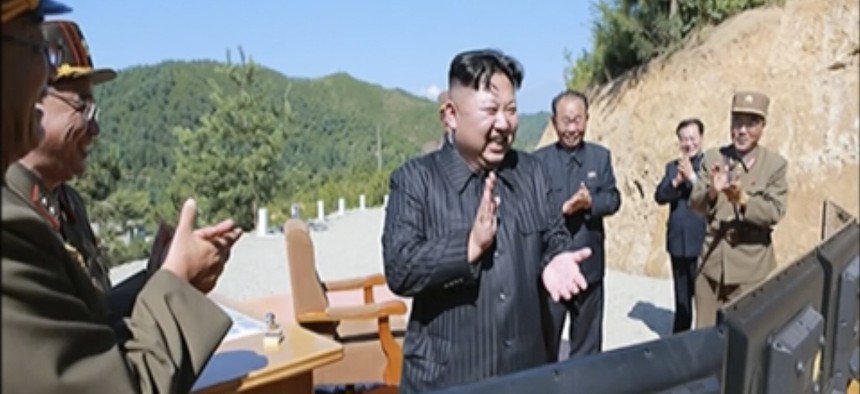
North Korea leader Kim Jung Un, center, applauding after the launch of a Hwasong-14 intercontinental ballistic missile, ICBM, in North Korea's northwest, July 4, 2017. AP
What Did North Korea's Missile Test Really Change?
When potential death tolls are unthinkably high, it’s like multiplying infinity.
North Korea’s successful test earlier this week of an intercontinental ballistic missile (ICBM) has triggered all of the expected alarms.
Even if Kim Jong Un cannot yet mount one with a nuke, his arsenal of chemical and biological weapons now has a longer reach—even, most experts agree, Hawaii or Alaska. But apart from the psychological impact on Americans, the development doesn’t fundamentally alter the military standoff that has been in place for decades.
Kim and his father before him have long had the capability of inflicting mass casualties on South Korea and the nearly 30,000 American forces stationed there. In recent years, the range of Pyongyang’s missiles has included Guam and targets in Japan. If conflict broke out, these are weapons that could kill hundreds of thousands, if not millions, and could be delivered so rapidly there is little chance of preventing some from reaching their targets.
So unless the lives of Americans on American soil are inherently more significant than the lives of those serving in that part of the world, or than Korean and Japanese lives, the game is the same. When death tolls are unthinkably high, it’s like multiplying infinity.
Using weapons like these would cause one the greatest tragedies in human history, or what Defense Secretary James Mattis has more modestly termed, “probably the worst kind of fighting in most peoples’ lifetimes.” The “most” in that assessment would presumably apply to those who are not old enough to remember Hiroshima and Nagasaki. It would also be suicidal for North Korea, and, it ought to be mentioned, a terrible blow to the planet.
For all these reasons, it is doubtful this most recent development—alarming as it is—will significantly change things. Kim’s possessing an ICBM, and eventually a nuclear-tipped one, was likely to happen sooner or later. It will give Kim more leverage in his dealings with South Korea. One of his long-term strategic goals is to drive a wedge between Seoul and Washington, something President Trump’s belligerent tweets—he had vowed to prevent Kim from developing a nuclear-tipped ICBM—may actually help accomplish. South Korea’s new president, Moon Jae In, has been making efforts in the opposite direction, trying to ease tensions with Pyongyang, and Trump’s “America First” policy ought to sow misgivings in Seoul about American intentions.
If Kim were ever able to pressure Moon into disinviting American forces from Korea, he would be a step closer to reuniting the peninsula under his rule. Neither scenario is likely, and South Korea alone is already more than a military match for its northern cousins.
So the standoff will remain. The American response so far has reflected the more sensible side of Trump’s administration, reflecting what The New York Times has called the president’s “brutal education” about the region. American and South Korean forces staged a joint missile exercise to demonstrate their readiness, and Secretary of State Rex Tillerson has called for “global action”—tougher worldwide sanctions. Neither will halt Kim’s determined progress. The United States and its regional allies have lived with North Korea’s threat for many years, and it isn’t going to suddenly go away.

